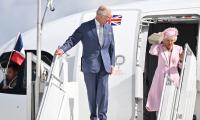KARACHI: Pakistan is making substantial progress in developing its financial sector on the back of regulatory improvements and other reforms, according to the Economic Survey 2020/21 released on Thursday.
Financial development (ie financial depth) can be measured by different macroeconomic variables such as domestic credit to the private sector as a percentage of gross domestic product, money supply measures and stock market indicators.
The financial depth is measured by the M2/GDP ratio, which is widely used as an indicator for financial sector deepening, where higher values represent a more developed financial sector.
“This [M2/GDP] ratio has witnessed substantial rise and increased from 36.6 percent in FY2011 to 50.3 percent in FY2020, indicating a more developed and efficient financial sector due to SBP’s various initiatives for financial sector development,” the survey said.
The increasing trend has continued in the current fiscal year and the ratio has increased to 47.3 percent as on April 30, 2021, compared with 46.9 percent during the same period last year.
A well-developed financial sector plays an important role in the overall economic development, it said.
Liberalisation of the financial sector in Pakistan is being pursued since late 1980s. The financial sector reforms were primarily aimed to promote economic development of the country in general and the financial intermediation in particular, the survey added.
The SBP introduced financial sector reforms in July-March FY2021 to create a conducive and thriving environment for the banking industry.
In line with the international best practices, the SBP introduced a comprehensive set of reforms to enhance supervision and resilience of the banking system while balancing the need to dampen the effects of Covid-19. The SBP also took measures to facilitate banks, depositors and borrowers of all segments to withstand the economic shocks of the coronavirus pandemic.
It relaxed the requirements of the Basel III capital framework, whereby the capital conservation buffer was reduced by 1 percent from 2.50 percent to 1.50 percent.
Similarly, the limit of the retail portfolio was also enhanced from Rs125 million to Rs180 million to support the growth of credit to the retail sector and small and medium enterprises.
The margin requirement for exposure against shares was reduced from 30 percent to 20 percent and margin calls from 30 percent to 10 percent.
The SBP revamped anti-money laundering and counter financing of terrorism regulatory regime to align with Financial Action Task Force recommendations.
The SBP allowed non-resident Pakistanis and Pakistan Origin Card (POC) holders to open Roshan Digital Accounts (Foreign Currency Value Account (FCVA) and NRP Rupee Value Account (NRVA)). In addition, resident Pakistanis having assets abroad, duly declared with FBR, have also been allowed to open Roshan Digital Account (FCVA only).
The SBP, over time, has eased the restrictions on foreign exchange related transactions, making these transactions effective and efficient while also improving the ease of doing business.
It launched an online platform ie Regulatory Approval System (RAS) to facilitate online submission of foreign exchange related cases to SBP.
The survey stated that the banking sector performed reasonably well in 2020, despite pandemic-induced vulnerabilities.
The asset base of the banking sector expanded to 14.2 percent in 2020 from 11.7 percent expansion in 2019. Robust rise in assets was primarily driven by a surge in investments (mainly in government securities) which increased by 33.5 percent. Advances’ growth, however, remained weak owing to economic slowdown triggered by the pandemic.
Deposits of the banking sector increased 16.1 percent to Rs18.5 trillion last year, according to the survey.
The after-tax profit of the banking sector increased 42.9 percent to reach Rs244 billion in 2020 against Rs171 billion in the previous year.
The solvency of the banking sector continued to strengthen, indicating elevated capacity of the banks to sustain stress from unexpected shocks. Capital Adequacy Ratio of the banking sector was at 18.6 percent by end December 2020—well above the local and international minimum benchmarks of 11.5 percent and 10.5 percent, respectively.
This picture released on August 13, 2023, shows WAPDA House in Lahore. — Facebook/WAPDALAHORE: Water and Power...
This image released on April 18, 2024, shows the meeting on Kisan Card at the Sindh Secretariat. — Facebook/Jam...
Pakistan State Oil HQs can be seen in this picture. — PSO websiteKARACHI: Pakistan State Oil and Pakistan Railways ...
This representational image shows gold bars. — UnsplashKARACHI: Gold prices increased by Rs500 per tola on Friday in...
Representational image of a working oil pumpjack. — AFP/FileLONDON: Plentiful supplies of some of the biggest crude...
Prime Minister personally promises to ensure that our bureaucracy does not play tricks with them







